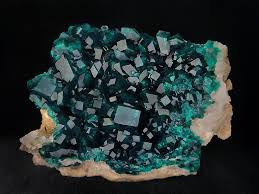
Dioptase: The Emerald of Intensity
Dioptase is a striking copper cyclosilicate renowned for its vivid emerald-green to bluish-green hues. Though often overshadowed by emerald, Dioptase shines in raw form with a brilliance and saturation that captivates collectors and crystal enthusiasts alike.
1. Geological Profile & Composition
-
Chemical Composition & Structure:
Dioptase is classified as a copper cyclosilicate with the chemical formula Cu₆Si₆O₁₈·6H₂O. It crystallises in the trigonal system, typically forming delicate prismatic or triangular-shaped crystals, with occasional drusy clusters that catch the light beautifully. -
Colour & Lustre:
Its rich green is a result of copper content, ranging from forest-green to deep bluish-green. The gemmy transparency and brilliant vitreous lustre render it a jewel-dimension masterpiece even in raw crystal jewellery contexts. -
Global Origins:
Notable sources include the Tsumeb Mine in Namibia—renowned for intense, sharp crystals—and the Katanga region of the Democratic Republic of Congo, Chile’s Alcaparrosa, and select sites in Kazakhstan and the USA. Namibian specimens of Dioptase are exceptionally prized for their clarity and intense colour.
2. Energetic Meaning & Healing Properties
-
Emotional & Heart Healing:
Dioptase is considered a powerful “heart-healer” gemstone. It opens the heart chakra, facilitating the release of grief, resentment, and emotional wounds, and replaces them with compassion, forgiveness, and unconditional love. -
Spiritual Transformation:
Many users describe profound energetic shifts—heightened heart-centred awareness, clarity of purpose, and a surge of creative insight. It’s often used in meditative practices to deepen awareness and strengthen spiritual sensitivity. -
Physical Aids:
Though traditional healing claims are anecdotal, Dioptase is sometimes used for issues related to the heart, respiratory system, and adrenal health—via place-on-body placement or elixir methods.

3. Collector’s Delight & Natural Uniqueness
-
Crystal Habit & Aesthetic:
Rarely does one encounter Dioptase in faceted form; instead, its true splendour resides in clusters or drusy aggregates that showcase raw crystal beauty. The fine balance between fragility and brilliance makes each piece unique. -
Rarity & Market Value:
Owing to its brittle nature and limited deposits—particularly high-grade Namibian specimens—Dioptase commands high value among collectors. Tsumeb finds from the 1970s, for example, are still cherished and priced accordingly. -
Natural Specimen Appeal:
Specimens often display a combination of formal crystals on matrix, sometimes layered over calcite, suggesting both geological narrative and aesthetic drama. Their iridescence under sunlight makes them brilliant display pieces.
4. Comparisons with Other Green Minerals
-
Versus Emerald:
While emerald (beryl) offers hardness and gem-quality durability, Dioptase outshines it in colour intensity, with more neon-like green tones. However, Dioptase scores only 5 on Mohs hardness compared to emerald's 7.5–8, making it unsuitable for daily wear in faceted jewellery. -
Contrasted with Malachite/Chrysocolla:
These copper-based greens have softer hues and opaque appeal. Dioptase, by contrast, dazzles with brilliance and prismatic clarity, more resembling fine precision-cut gemstones—even in raw crystal jewellery pieces.
5. Use in Jewellery – Raw Elegance Meets Vibrancy
Despite its fragility, Dioptase holds a special place in the world of raw crystal jewellery and mineral specimen adornment. It is rarely faceted, but its beauty lies precisely in its unaltered form.
-
Crystal Specimen Rings & Pendants:
Dioptase is most often showcased in mineral specimen necklaces or handmade gemstone rings where the crystal remains exposed on a natural matrix. These pieces appeal to connoisseurs who value the integrity and wild geometry of earth-formed structures. -
Aesthetic Pairings:
Jewellery designers frequently pair Dioptase with neutral tones—think sterling silver, clear quartz, or pale calcite—to allow the gem’s luminous green to take centre stage. In Oryssia's collections, pieces featuring matrix-attached Dioptase are not only talismanic but artistically raw. -
Caring for Dioptase Jewellery:
Owing to its softness (Mohs 5) and cleavage, Dioptase is best worn with mindfulness—ideal for ceremonial or light daily wear rather than rugged use. Storage should avoid high humidity or sharp changes in temperature.

6. Cultural Symbolism & Mystical Lore
Although Dioptase is not as steeped in ancient lore as some crystals, it has gained spiritual reverence in modern metaphysical circles:
-
Mystic Origins:
In contemporary crystal healing, Dioptase is considered a stone of the “inner child,” believed to bring forgotten memories to the surface and offer healing through deep, heart-centred work. -
Symbolism of Rebirth:
With its vibrant green fire, Dioptase is often associated with rebirth, aligning the wearer with nature’s regenerative cycles—especially spring, verdancy, and growth. -
Modern Use in Rituals:
Practitioners sometimes place Dioptase on their altar during heart chakra work, forgiveness rituals, or full moon intentions focused on healing past wounds and attracting pure love.
7. The Oryssia Perspective
At Oryssia, we honour stones like Dioptase not merely for their physical beauty but for the energetic resonance they hold. Dioptase, in its natural crystalline expression, is not only a jewel but a story—a portal to forgiveness, restoration, and vibrant emotional clarity.
Each crystal specimen ring or mineral specimen necklace created with this stone is more than adornment; it’s an embodiment of the Earth’s healing spectrum, hand-crafted to bring that power close to the skin.